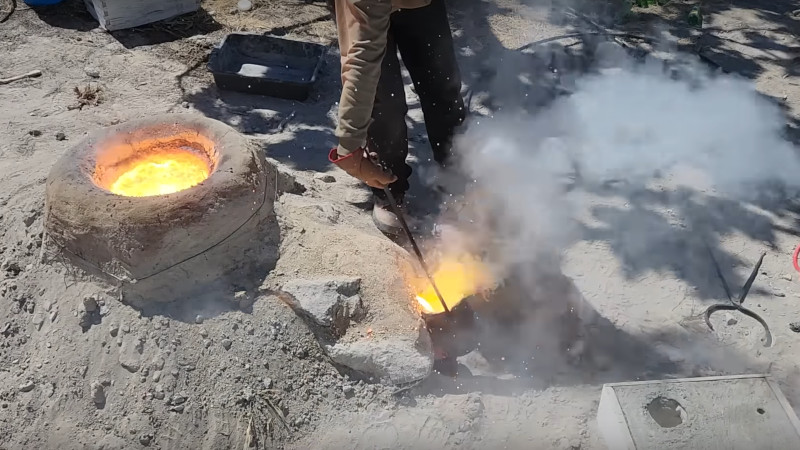The thermite process is a handy way to generate molten iron in the field. It’s the reaction between aluminium metal and iron oxide, which results in aluminium oxide and metallic iron. It’s hot enough that the iron is produced as a liquid, which means it’s most notably used for in-field welding of things such as railway tracks. All this is grist to [Cody’s Lab]’s mill of course, so in the video below the break he attempts to use a thermite reaction in a rough-and-ready foundry, to make a cast-iron frying pan.
Most of the video deals with the construction of the reaction vessel and the mold, for which he makes his own sodium silicate and cures it with carbon dioxide. The thermite mix itself comes from aluminium foil and black iron oxide sand, plus some crushed up drinks cans for good measure.
The result is pretty successful at making a respectable quantity of iron, and his pour goes well enough to make a recognizable frying pan. It has a few bubbles and a slight leak, but it’s good enough to cook an egg. We’re sure his next try will be better. Meanwhile this may produce a purer result, but it’s by no means the only way to produce molten iron on a small scale.
















A small cupola would be far more useful. One foundry in the early part of the last century made one out of small barrel. Nail keg IIRC and ran it on their float in a parade actually melting and casting during the parade. Probably no more than a 1/2 kg per run, but good enough to demonstrate the technology. Really have to admire the guys who did that.
Steve Chastain has an excellent book on the subject. Lindsay Books reprinted quite a few others, but alas, it closed.
I have a 2 m tall leaky well water tank I got for free which I hope to get around to lining. It’s large enough for 30-50 kg an hour.
500g/run? why bother with the hassle of fueling a cupola for that little?
You only need ~6-8kw of induction power to manage that little load bump it up to 10kw and you can melt that much in around a minute,
Just remember to not use copper.
https://youtu.be/Wkqo7QQJuV8
I wonder why he didn’t use the classic green sand casting method to make the mould?
Sodium silicate as a binder is a classic green sand process. Though usually reserved for cores.
Thermite is also a good way to really destroy your old hard drive. Don’t want to risk FBI or NSA finding your stash of porn? take the drive out, take it outside, pile on iron and aluminum powder, light it, and back away. The drive will be reduced to slag with no hope of data recovery.
PS don’t do this inside home, they burn very hot and will burn the house down. Do it outside and in where there’s nothing combustible like dry grass to catch on fire.
“Light it.” Because it’s that easy.
It usually lights pretty easily with a strip of magnesium.
I’ve heard that party sparklers work well to light thermite.
It’s quite interesting to make thermite without aluminium powder. But with all the foil and cans I thing he does not get pure iron.
I was wondering about that. I know if you leave iron or steel in aluminum when you melt it it changes it some, it would seem that having the combo of the two in thermite would give you some kind of an odd alloy. Still a very cool video. Cody is always fun to watch.
Because iron and aluminum have different melting points they separate during the reaction so you get iron on the bottom and aluminum up top. When joinng railroad rails the weld ends up being steel (carbon added to the iron powder) and an aluminum slag as waste on top which is cut off. There is a calibrated plug that drops the molten metal once they have liquified and separated.
And remember that properly mixed thermite doesn’t produce MELTING iron, it produces BOILING iron.
Cody’s Lab videos always make me smile. Cheerful guy living his own life of fun projects just for his own entertainment (and ours).